The 2018 IEEE EMC+SIPI event returned to Long Beach, CA after last visiting in 2011. The event continues to include Signal Integrity & Power Integrity (SIPI) as part of the conference, reflecting the EMC Society’s influence and focus on this critical topic of engineering design. A new special event was the short course led by noted author, Professor Constantine Balanis, providing an overview of fundamental and advanced antenna topics. There was also the Global EMC University that featured an overview of fundamental topics by expert instructors designed for those new to the field of EMC and SIPI. The event brought back the EMC+SIPI 2018 Online Symposium which allows us to connect to the community virtually. Engineers can join the event via computer or mobile device and view content online. In the exhibition, we found the following interesting products and highlights:
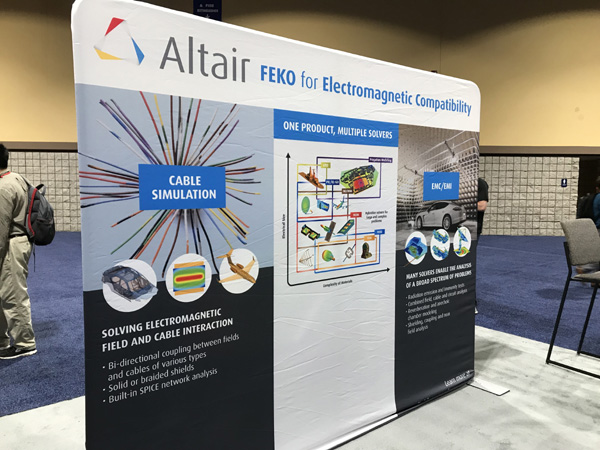 Altair was part of our recent cover story on EDA Platforms. One of the most notable features of the recent 2018 release is the inclusion of WinProp with FEKO as part of the standard HyperWorks installation. WinProp is a dedicated tool for wave propagation modeling and radio network planning interfacing with FEKO. WinProp’s accurate and fast empirical and deterministic propagation models are available for a wide range of scenarios: rural, urban, indoor, tunnel, vehicular. WinProp supports arbitrary transmitters including cellular and broadcasting sites, satellites, repeaters and leaky feeder cables. WinProp’s propagation engines include empirical and semi-empirical models (calibration with measurements possible), 3D ray tracing models, as well as the unique dominant path model. Besides the prediction of the path loss, the delay and angular spread can be computed, as well as LOS/NLOS, directional channel impulse response, angular profile and propagation paths.
Altair was part of our recent cover story on EDA Platforms. One of the most notable features of the recent 2018 release is the inclusion of WinProp with FEKO as part of the standard HyperWorks installation. WinProp is a dedicated tool for wave propagation modeling and radio network planning interfacing with FEKO. WinProp’s accurate and fast empirical and deterministic propagation models are available for a wide range of scenarios: rural, urban, indoor, tunnel, vehicular. WinProp supports arbitrary transmitters including cellular and broadcasting sites, satellites, repeaters and leaky feeder cables. WinProp’s propagation engines include empirical and semi-empirical models (calibration with measurements possible), 3D ray tracing models, as well as the unique dominant path model. Besides the prediction of the path loss, the delay and angular spread can be computed, as well as LOS/NLOS, directional channel impulse response, angular profile and propagation paths.
ANSYS was part of our recent cover story on EDA Platforms. The ANSYS Electronics Desktop is a design platform created for the electrical engineer with a single interface to access the ANSYS physics solvers (HFSS, HFSS SBR+, Maxwell, Icepak, Q3D Extractor, SIwave) and circuit/system simulators (Nexxim, Simplorer, EMIT) with direct import of ECAD/MCAD geometry. ANSYS EMIT is used for modeling installed antenna-to-antenna coupling. The result is a complete solution to reliably predict the effects of RFI in multi-antenna environments with multiple transmitters and receivers. EMIT’s powerful analysis engine computes all important RF interactions including nonlinear system component effects. These effects can produce high order intermodulation products that often lead to RFI. Diagnosing RFI in complex environments is notoriously difficult to perform in a testing environment, but with EMIT, the identification of the root-cause of any interference is rapidly accomplished via graphical signal trace-back and diagnostic summaries that show the exact origin and path that interfering signals take to each receiver.
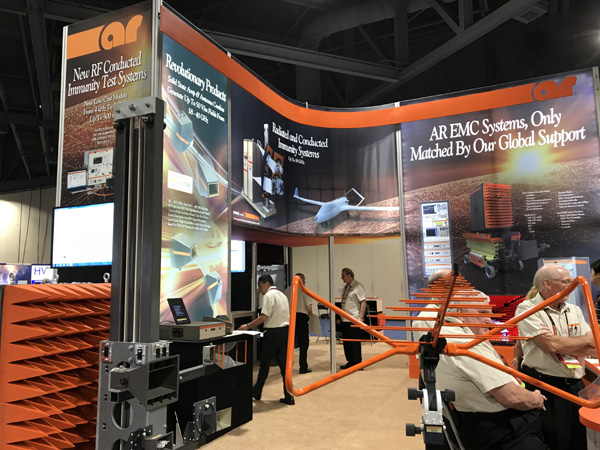 AR Worldwide was highlighting their Model 250U1000 which is a solid-state, self-contained, air-cooled, broadband amplifier designed for applications where instantaneous bandwidth, high gain and linearity are required. When used with a sweep generator, it will provide a minimum of 250 watts of RF power. Included is a front panel gain control which permits the operator to conveniently set the desired output level. The 250U1000 is protected from RF input overdrive by an RF input leveling circuit which controls the RF input level to the RF amplifier first stage when the RF input level is increased above 0 dBm.
AR Worldwide was highlighting their Model 250U1000 which is a solid-state, self-contained, air-cooled, broadband amplifier designed for applications where instantaneous bandwidth, high gain and linearity are required. When used with a sweep generator, it will provide a minimum of 250 watts of RF power. Included is a front panel gain control which permits the operator to conveniently set the desired output level. The 250U1000 is protected from RF input overdrive by an RF input leveling circuit which controls the RF input level to the RF amplifier first stage when the RF input level is increased above 0 dBm.
AR was also featuring the CL-105A/CL-106A Shielded Enclosure Leak Detection System (SELDS) that provides a convenient means of testing the electromagnetic shielding effectiveness of EMI enclosures by looking at the most likely points of degradation – the seams, doors and filter connections. The system consists of a Model CL-105A Transmitter, Model CL- 106A Receiver, headphones and a rugged carrying case. The incredible sensitivity of the model CL-105A Receiver allows it to meet the most rigid MIL standards (e.g. MIL-STD-188/125) for shielded room acceptance.
AR’s demonstrated its new “AA” Series produce field strengths up to 50V/m in two band-specific models over the 18 to 40 GHz frequency range when driven with a suitable signal generator below along with a message from the new COO, John Kim.
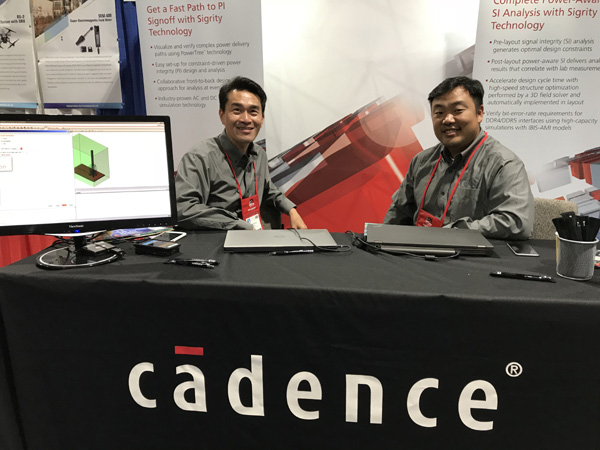 Cadence’s Sigrity 2018 Release accelerates PCB design cycles by integrating 3D design and 3D analysis. It has upgraded interconnect modeling technology addresses latest trends on PCB and IC package design. With signal speeds climbing to 32Gbps and faster, the need to strategically model PCBs and connectors as one structure is now required. The new Cadence® Sigrity™ 3D Workbench, included with the Sigrity PowerSI 3D EM Extraction Option (3DEM), allows users to import mechanical structures, such as cables and connectors, and merge them with the PCB so critical 3D structures that cross from the board to the connector can be modeled and optimized as one structure. Updates to the PCB can be automatically back-annotated to the PCB layout tool. Other new features can be found online with the 2018 release information.
Cadence’s Sigrity 2018 Release accelerates PCB design cycles by integrating 3D design and 3D analysis. It has upgraded interconnect modeling technology addresses latest trends on PCB and IC package design. With signal speeds climbing to 32Gbps and faster, the need to strategically model PCBs and connectors as one structure is now required. The new Cadence® Sigrity™ 3D Workbench, included with the Sigrity PowerSI 3D EM Extraction Option (3DEM), allows users to import mechanical structures, such as cables and connectors, and merge them with the PCB so critical 3D structures that cross from the board to the connector can be modeled and optimized as one structure. Updates to the PCB can be automatically back-annotated to the PCB layout tool. Other new features can be found online with the 2018 release information.
CST, now part of the SIMULIA brand of Dassault Systèmes, is integrating its software with the 3DEXPERIENCE platform, which connects CAD, PLM, collaboration and other leading edge simulation software, to provide a complete multi-domain and multiphysics solution. They also were part of our recent cover story on EDA Platforms. EMC and EMI are significant concerns in product design and if not caught as early as possible, installed performance and interference problems can significantly delay the development of a product or require costly and reputational damaging recalls. With the new CST Interference Task, potential interference problems can be identified at the design stage, helping ensure compliance with legal regulations and reducing the risk of unexpected issues emerging during testing. For devices used near the body, there are also legally-mandated limits on the exposure to RF fields, measured as SAR. These, too, can be simulated with CST STUDIO SUITE to check design compliance with regulations.
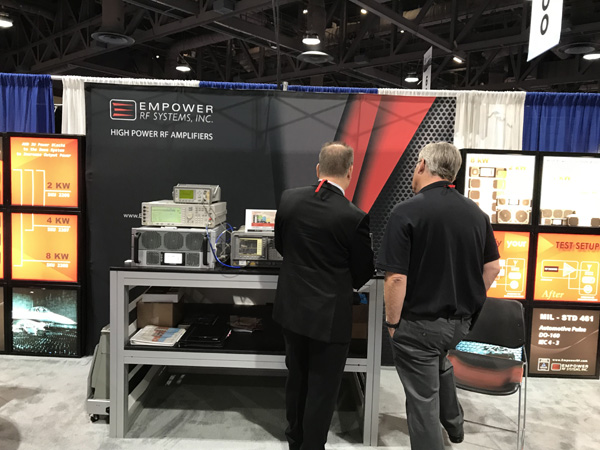 Empower RF Systems once again conducted a live demonstration of broadband, high-power amplifiers with high performance, small size, IoT interface, and user selectable functionality. They showcased one of their popular models, the 2170, operating from 1 to 3 GHz at 1 kW in a 5U chassis. The 2170 is a member of Empower’s Next Gen family of high-power amplifiers that is the result of a new design combining advances in RF components, digital loop control, real-time software, HTML GUI, thermal and electro-mechanical design to create a flexible, compact, rugged and future proof amplifier. In addition to industry leading SWaP performance, the demonstration team will exercised the system software that makes this a truly configurable amplifier with modulation and output power modes that are selectable. Besides the common industry open loop mode of Manual Gain Control (MGC) the amplifier can be operated in closed loop modes (AGC or ALC) to speed up and simplify testing.
Empower RF Systems once again conducted a live demonstration of broadband, high-power amplifiers with high performance, small size, IoT interface, and user selectable functionality. They showcased one of their popular models, the 2170, operating from 1 to 3 GHz at 1 kW in a 5U chassis. The 2170 is a member of Empower’s Next Gen family of high-power amplifiers that is the result of a new design combining advances in RF components, digital loop control, real-time software, HTML GUI, thermal and electro-mechanical design to create a flexible, compact, rugged and future proof amplifier. In addition to industry leading SWaP performance, the demonstration team will exercised the system software that makes this a truly configurable amplifier with modulation and output power modes that are selectable. Besides the common industry open loop mode of Manual Gain Control (MGC) the amplifier can be operated in closed loop modes (AGC or ALC) to speed up and simplify testing.
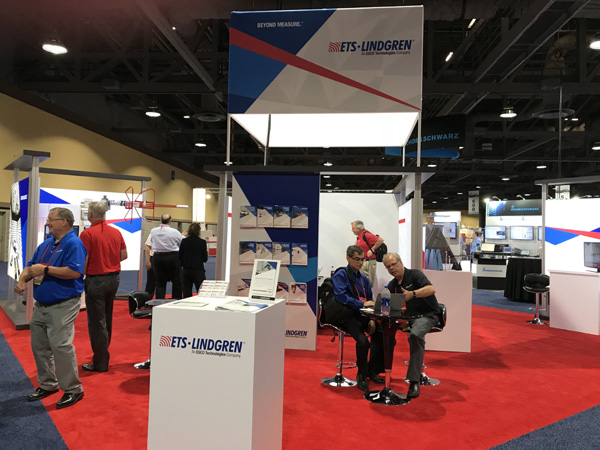 For more than 75 years, ETS Lindgren has been building a wide range of high-performance products and accessories renowned for setting the research, development, production, and service standards of any industry served. From chambers to software, absorbers to antennas, ETS-Lindgren’s products are designed for ease-of-use, reliability and durability, with attention to diversity, scale and precision. They offer standard solutions for emissions testing, such as CISPR 11, 16, 22, 25 or 32. Additionally, they have proven and tested immunity packages for IEC/EN 61000-4-3 and IEC/EN 61000-4-6. These systems are designed around our semi-anechoic chambers, antennas and field probes, positioning systems, EMCenter™ RF Test System Platform, instrumentation and amplifiers, and TILE!™ Lab Management Software. I was most impressed with their 5G mmWave beamforming characterization system that was demonstrated in their booth.
For more than 75 years, ETS Lindgren has been building a wide range of high-performance products and accessories renowned for setting the research, development, production, and service standards of any industry served. From chambers to software, absorbers to antennas, ETS-Lindgren’s products are designed for ease-of-use, reliability and durability, with attention to diversity, scale and precision. They offer standard solutions for emissions testing, such as CISPR 11, 16, 22, 25 or 32. Additionally, they have proven and tested immunity packages for IEC/EN 61000-4-3 and IEC/EN 61000-4-6. These systems are designed around our semi-anechoic chambers, antennas and field probes, positioning systems, EMCenter™ RF Test System Platform, instrumentation and amplifiers, and TILE!™ Lab Management Software. I was most impressed with their 5G mmWave beamforming characterization system that was demonstrated in their booth.
Exodus Advanced Communications recently released the AMP4052, 32-40 GHz, 10 W, 40 dB, 100-240 VAC system. This Class AB linear State of the Art Solid State Power Amplifier features an instantaneous wide-band GaAsFET design with built-in protection circuits for high reliability and ruggedness. The AMP4052 is suitable for all single channel modulation standards. It is packaged in a 2.5U Chassis with an approximate weight of 11 kilograms. This System is available with a Digital Monitor & Control upon request. Typical applications for this System are EMI/RFI Testing, Ka band SATCOM and General Millimeter Testing. They also recently released the AMP2131P, 500-1000 MHz, 10 kilowatt PULSE, 70 dB, 208 VAC system. This Class AB linear State of the Art Solid State High Power Amplifier features instantaneous wide-band LDMOS design with versatile interface options, built-in control, monitoring and protection circuits for high reliability and ruggedness. Additional specifications include -80 dBm Noise Quieting and an Efficiency of >10 %. The AMP2131P is housed in a 10U Rack Mount Chassis. Options include a Digital Monitor & Control with Ethernet, USB, RS-232 and GPIB IEEE available upon request. Typical applications include UHF jamming, UHF Communications, EMI/RFI Testing, Semiconductor and General Testing where high peak power levels are required.
KEMET recently introduced two new series of power film capacitors that meet the requirements of AEC-Q200. The C4AQ series is suited for industrial, automotive and power supply designs for DC link, DC filtering and energy storage applications, while the C4AF series addresses similar applications, but is specifically designed for harsh environments. The new RoHS compliant capacitors have a polypropylene metalized film construction and are available as two or four radial leaded board mount devices. Available values for the C4AQ series range from 1.0 to 130 µF, with additional sampling for 170 µF and 210 µF. Voltage values span from 500 to 1500 VDC. Devices from the C4AF series are designed for use in more demanding and harsh applications and are offered in capacitance values up to 62 µF with voltage ratings up to 400 VAC.
GAUSS INSTRUMENTS was showing off their new product line, TDEMI ULTRA, which is claimed to be the most powerful measurement equipment for emission testing. By using the patented GAUSS INSTRUMENTS’ technology, with an advanced DSP concept in combination with best in class performance RF components and microwave circuits, it has a multi-GHz real-time scanning feature, ultrafast receiver scanning, and dynamic range of about 100 dB (@0 dB attenuation and pre-selection off) or up to more than 170 dB including the automatically stepped attenuator and an ultrahigh performance pre-selection. The system combines an ultrahigh performance stepped scan mode with ultrahigh performance technology. This enables the instrument to speed up the conventional stepped scan mode by orders of magnitude in combination with an ultrahigh performance pre-selection and a highly linear input stage that claims to supersede all prior technology, especially for pulses and pulse modulated carriers. It is available in frequency ranges of 6 GHz, 18 GHz, 26.5 GHz or 40 GHz. The TDEMI ULTRA measurement system provides a fully integrated spectrum analyzer and also a real-time spectrum analyzer.
 MVG was showing off their latest range of polypropylene absorbers made for EMC test chambers as well as recently launched EMC antennas and test chambers. Visitors were able to experience a virtual visit of a full turnkey solution made for PitRadwar, including a 12’ high EMC chamber made for military radar compliance and state-of-the-art reflector, positioning and scan technology. MVG’s SmartShield modular shielding and precision cut and coated absorbers are designed with the flexibility to meet specific customer requirements. They have over 30 years of experience that ensures the high quality and durability of their products. For EMC Test and Measurement Solutions they design, manufacture, supply and install shielded enclosures, anechoic chambers, shielded doors, absorbers and more. Through their partnership with Amplifier Research (AR), they can provide exceptional turnkey solutions for the most demanding EMC requirements.
MVG was showing off their latest range of polypropylene absorbers made for EMC test chambers as well as recently launched EMC antennas and test chambers. Visitors were able to experience a virtual visit of a full turnkey solution made for PitRadwar, including a 12’ high EMC chamber made for military radar compliance and state-of-the-art reflector, positioning and scan technology. MVG’s SmartShield modular shielding and precision cut and coated absorbers are designed with the flexibility to meet specific customer requirements. They have over 30 years of experience that ensures the high quality and durability of their products. For EMC Test and Measurement Solutions they design, manufacture, supply and install shielded enclosures, anechoic chambers, shielded doors, absorbers and more. Through their partnership with Amplifier Research (AR), they can provide exceptional turnkey solutions for the most demanding EMC requirements.
Noisewave highlighted their NW3G-EMC radiated noise source that is used for quick site verification of EMC test chambers or ranges. It is portable, battery powered and easy to sue. Broadband noise offers several advantages over both swept sources and comb generators by combing stability, speed and complete spectral coverage. Their crystal free design makes them less susceptible to frequency drift over both time and temperature. This one outputs 1-3 GHz broadband noise with amplitude stability of +/- 0.1 dB using a 2” monopole antenna.
 R&S was displaying a wide range of products and solutions including their partnership with AP Americas for anechoic chambers. They were featuring the R&S®BBA130 broadband amplifiers that offer a variety of setting options that can optimally tune the output signal to a specific application. During operation, the engineer can adjust the operating class for transistors between Class A and Class AB as well as choose between maximum output power or higher mismatch tolerance at the output. The primary area of application for R&S®BBA130 broadband amplifiers is design and product validation testing during RF component development, production and quality assurance. The R&S®BBA130 broadband amplifiers feature a lightweight, modular design that is optimized for the specific frequency range. The modular design allows you to later upgrade the power and frequency range.
R&S was displaying a wide range of products and solutions including their partnership with AP Americas for anechoic chambers. They were featuring the R&S®BBA130 broadband amplifiers that offer a variety of setting options that can optimally tune the output signal to a specific application. During operation, the engineer can adjust the operating class for transistors between Class A and Class AB as well as choose between maximum output power or higher mismatch tolerance at the output. The primary area of application for R&S®BBA130 broadband amplifiers is design and product validation testing during RF component development, production and quality assurance. The R&S®BBA130 broadband amplifiers feature a lightweight, modular design that is optimized for the specific frequency range. The modular design allows you to later upgrade the power and frequency range.
They also had on display their new R&S®AdVISE software which is a video-based monitoring/advisory system for use in an EMC test environment. This video detection system is designed to automate the process of visually detecting failures of a DUT during immunity testing, eliminating human inattention and saving test time. Here is short demonstration along with their EMI receiver:
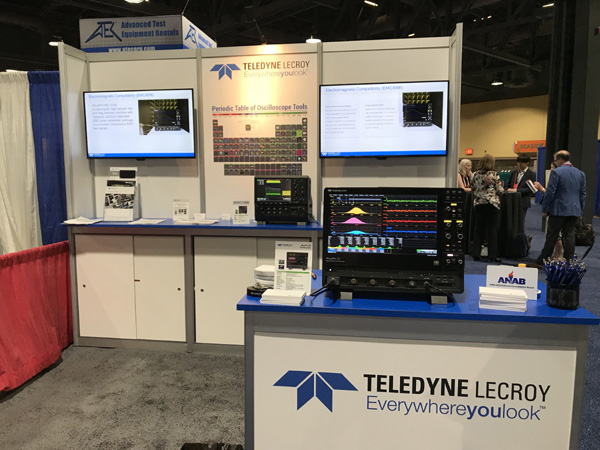 Teledyne LeCroy recently released WavePro HD high-definition oscilloscopes, which combine 12-bit technology and 8 GHz of bandwidth for low noise and clear signal fidelity. With a maximum of 5 Gpoints of fast acquisition memory, these oscilloscopes also acquire extremely fine waveform details over long periods of time. WavePro HD 12-bit oscilloscopes are targeted at engineers developing smaller, faster, and lower-power mobile and handheld devices; high-speed, deeply-embedded computing systems; and datacenter technologies. The oscilloscopes feature a large 15.6”, 1920 x 1080-pixel capacitive touch screen and Teledyne LeCroy’s powerful MAUI with OneTouch user interface for intuitive, efficient operation. The instruments come in four models with bandwidths from 2.5 GHz to 8 GHz, all featuring sample rates up to 20 GS/s. Here is a quick demo of the scope for ESD applications:
Teledyne LeCroy recently released WavePro HD high-definition oscilloscopes, which combine 12-bit technology and 8 GHz of bandwidth for low noise and clear signal fidelity. With a maximum of 5 Gpoints of fast acquisition memory, these oscilloscopes also acquire extremely fine waveform details over long periods of time. WavePro HD 12-bit oscilloscopes are targeted at engineers developing smaller, faster, and lower-power mobile and handheld devices; high-speed, deeply-embedded computing systems; and datacenter technologies. The oscilloscopes feature a large 15.6”, 1920 x 1080-pixel capacitive touch screen and Teledyne LeCroy’s powerful MAUI with OneTouch user interface for intuitive, efficient operation. The instruments come in four models with bandwidths from 2.5 GHz to 8 GHz, all featuring sample rates up to 20 GS/s. Here is a quick demo of the scope for ESD applications:
Vectawave Technology is now offering a GaAs solution to the 1-2 GHz range that is important to EMC. They are solid state TWT replacements, high reliability proven GaAs designs, Class A for maximum mismatch drive and meet the linear power requirements. They are available in 100, 200, 375 and 600 Watt versions plus new 4 kW pulsed version.

